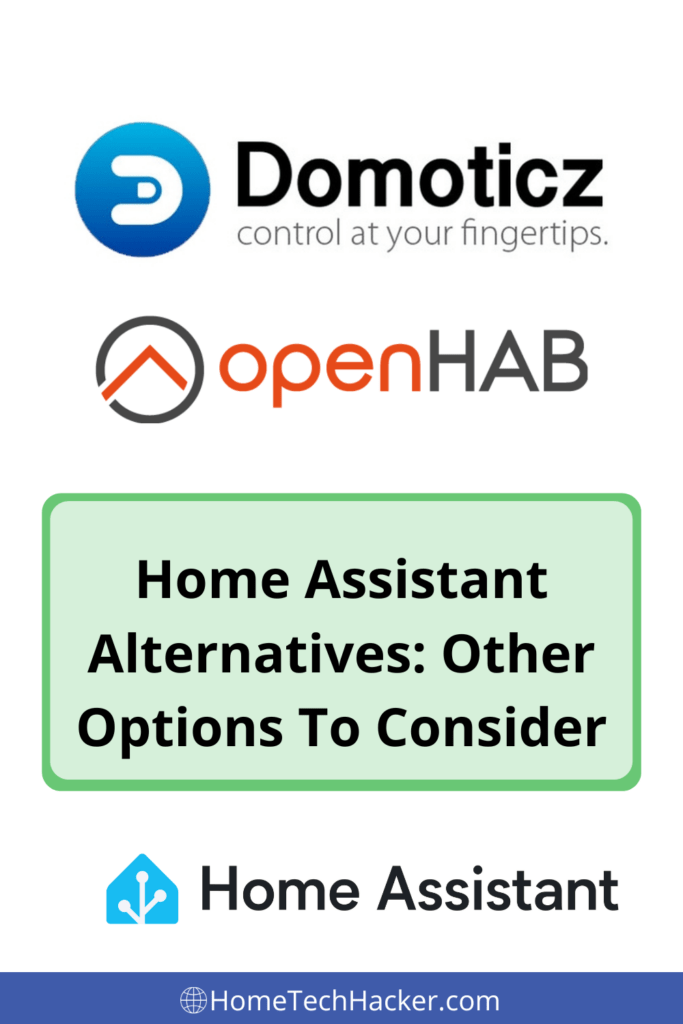
In my opinion, Home Assistant is the best smart home hub out there. Especially when you consider that it is open-source and free. But that’s just my opinion. It isn’t the only option. It’s not even the only option I considered when I first moved to it from my old Vera smart home hub. Let’s discuss some of the other options you might want to consider.
Background
There are lots of different types of smart home hubs out there. For example, there are hardware devices, like SmartThings and Hubitat. There are also voice assistant-based smart home hubs like Google Assistant- and Alexa-powered devices. These types of smart home hubs work well for many people. If you are looking for the best options for these types of hubs you should read my article about the top smart home hubs.
For this article, I am going to focus on software-based hubs. Specifically, I am going to discuss a couple of open-source free Home Assistant alternatives. Like Home Assistant, these alternatives can be downloaded for free and installed on the hardware of your choosing. I have a bias towards open-source products due to their transparency. They don’t try to hide what the code is doing, and that helps me feel a little better from a security standpoint.
With that background clarified, let’s compare and contrast a couple of Home Assistant alternatives.

Home Assistant Alternative 1: openHAB

openHAB, which stands for open Home Automation Bus, is an open-source home automation platform written in Java that started in 2010. Like Home Assistant, it is designed to be platform and vendor-agnostic. It can support Zigbee, Z-Wave, MQTT, Bluetooth, and more.
openHAB also can integrate with smart assistants like Alexa and Google Home. It also integrates with many other vendor ecosystems (it refers to these integrations as “bindings”) like Kasa, Lutron, and Philips Hue.
openHAB comparisons to Home Assistant
Similarities
On the surface, openHAB and Home Assistant have a lot of similarities. Both can do an excellent job of powering your smart home. Both have powerful and flexible user interfaces, and tons of integrations with other ecosystems, and have been around for over a decade. Additionally, they both have ample documentation, strong user communities, and run on a variety of software.
Differences
Although similar in these areas, there are some potentially important differences. Both have good documentation and user communities, but Home Assistant has much more extensive documentation and a larger user community. Additionally, due to its greater popularity, you can find much more information and tutorials about Home Assistant than you can for openHAB. The larger community overall leads to better support options.
Also, Home Assistant, especially if you include HACS (Home Assistant Community Store), integrates with many more products and ecosystems than OpenHAB. Home Assistant tends to add new integrations faster.
Speaking of faster, the development pace of Home Assistant seems to be faster overall. The good side of this is that new features and fixes are added more quickly than they are for openHAB. The downside is that Home Assistant’s more frequent release schedule can mean more work keeping up with changes, fixes, and bugs.
Some of the main differences come in how they do what they do. Although they both have powerful user interfaces and dashboards, their capabilities and the processes for configuring the user interfaces are very different.
The automation and script creation process is very different as well. Home Assistant has a powerful user interface for creating automations and scripts. Its primary automation/scripting language outside of the UI is YAML, although there are ways to use other languages like Python and shell scripts. openHAB has a UI-based rule creation engine as well. It natively supports three scripting languages (Rules DSL, ECMAScript 5.1, and Blockly) but can use many scripting languages via add-ons (e.g., JavaScript, Python, and Groovy).
Home Assistant Alternative 2: Domoticz

Domoticz is another free open-source home automation platform. It is written in C++ and had its first release in 2012. Like openHAB and Home Assistant, it is designed to be platform and vendor-agnostic. It can support Zigbee, Z-Wave, MQTT, and more.
Domoticz has many integrations (which it calls plugins) and can integrate with voice assistants like Google Assistant and Alexa.
Domoticz comparisons to Home Assistant
Similarities
Domoticz has many similarities with Home Assistant (and openHAB). Both have powerful interfaces and the ability to support complex automations. They both integrate with many other ecosystems. Additionally, both are fairly mature products that have been around for over a decade.
Differences
Although the overall intentions and capabilities of these products are similar, there are some stark differences in their capabilities. Domoticz is touted as being “lightweight” and working well on low-power machines. It is probably more lightweight than Home Assistant, but neither requires anything close to beefy hardware.
Like openHAB, Domoticz has a much slower pace of development. That’s useful if you don’t want to keep up with a lot of changes and you want more stability, but it also means new features arrive slower.
That rapid pace of development has also allowed Home Assistant to surpass Domoticz in integrations (especially with the aforementioned Home Assistant Community Store). This mostly matters if you are looking for an integration that doesn’t exist yet or integration with lesser-known ecosystems.
Home Assistant once again wins in the size of community and department. It’s much easier to find documentation and tutorials for Home Assistant than for Domoticz. That said, Domoticz has plenty of good documentation.
While Home Assistant primarily uses YAML as its scripting language, Domoticz uses Lua, but also natively supports Blockly, dzVents, and Python. Both can use and call other languages to write automations and scripts.
Which one should you use?
The best advice I can give is to look at your specific needs. Is there a particular integration you are looking for that is only available in one system or the other? Is there a scripting language you would specifically like to use that isn’t available in all three? Do you prefer stability over rapid changes?
If you think all three can do the job and you have the time, give them all a trial run. Although they all accomplish the same goal, they look, feel, and behave a little differently. One may fit your way of thinking and user interface needs better than another. The only way to truly know is to try all three.
That said, if you only have time to try one, I’d probably give Home Assistant a shot. I know I’m biased because that’s what I use now. However, it has the largest feature set, the most documentation, and the biggest community. I believe it has a good chance of meeting your needs.
Interested in supporting HomeTechHacker?
Have you found the content on this site useful? If so, are you interested in supporting me and this site? There’s no obligation of course, but I would really appreciate any support you can give. Below are a few ways you can show support:
- Share this site with your friends and on social media (use the sharing links at the end of this page for your convenience)
- Subscribe to this site
- Purchase one of my books, The Personal Cybersecurity Manual, The Home Network Manual or The Smart Home Manual, for yourself or as a gift
- Put a link to HomeTechHacker on a site you have access to. Be sure to let me know about it!
- Enroll in HomeTechHacker Academy for free and premium online home technology courses.
- Reach out to me via my contact page or Twitter and let me know something I should write about
- Shop at Amazon through my affiliate links and ads on these pages. See my disclosures for more details about affiliate links. You can also just shop from one of the links below:
- HomeTechHacker Shop: This is a listing of products that I use, have reviewed, and that I recommend
- HomeTechHacker Technology Advisor: This suite of tools will give you customized home technology product recommendations based on your needs
- My Amazon affiliate link: Just click on this link to go to Amazon and shop
Thank you! I really appreciate it!


